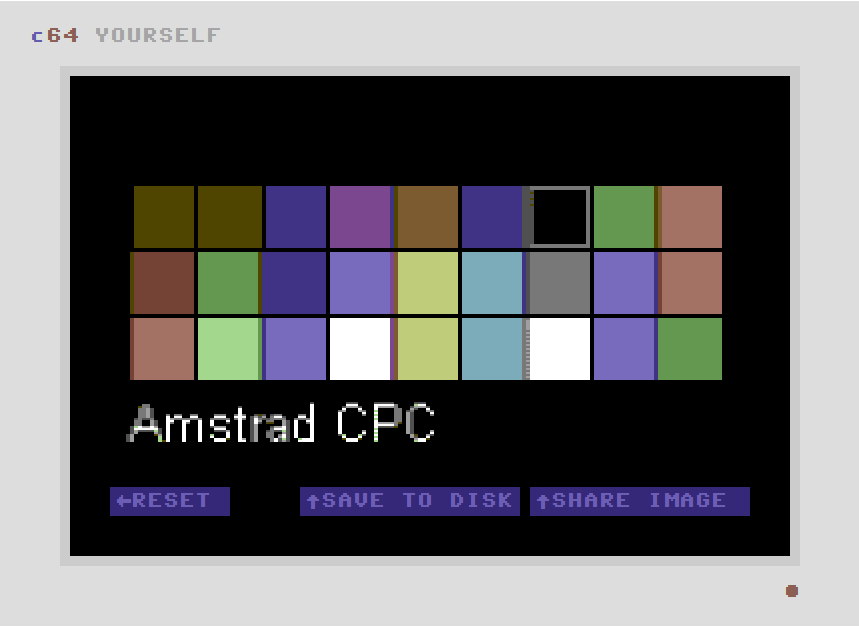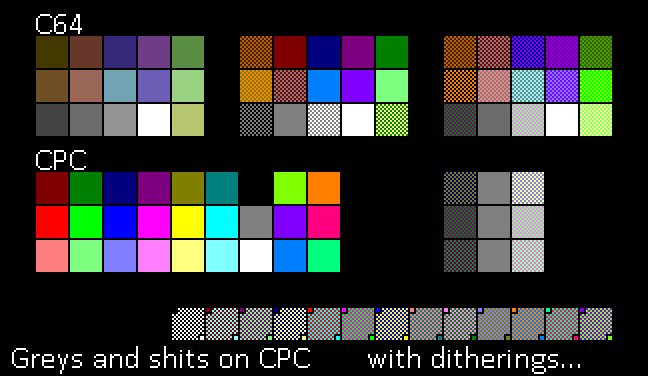Difference between revisions of "Comparing C64 to CPC"
From CPCWiki - THE Amstrad CPC encyclopedia!
m (→Palette comparison) |
|||
| Line 48: | Line 48: | ||
[[File:Colors.png]] | [[File:Colors.png]] | ||
| + | |||
| + | * C64 trying to replicate CPC colours palette (and failing). | ||
| + | |||
| + | [[File:CPC palette emulated on C64.png]] | ||
| + | |||
| + | * Amstrad CPC trying to replicate C64 grey palette (and somewhat almost succeeding). | ||
| + | |||
| + | [[File:Test gris CPC.png]] | ||
==Comparison of the SID and AY-3-8912== | ==Comparison of the SID and AY-3-8912== | ||
Latest revision as of 12:39, 9 August 2020
Contents
Comparing CPC and C64
- The C64 was released in 1982, the CPC released in 1984.
- The C64 was designed to be connected to a television (PAL: 50Hz, NTSC: 60Hz). The CPC was designed to be connected to an Amstrad GT65 green screen or CTM640/644 colour monitor.
- The C64 has a dedicated separate tape player. The CPC464 has a dedicated tape player built in, or for CPC664 and CPC6128 any tape player could be used with a suitable lead.
- The C64 has a palette of 16 colours. The Amstrad has a palette of 27 colours.
- The CPC colours have higher contrast and are brighter than the C64's colours.
- The C64 has a 1.0MHz 6510 CPU (a 6502 based CPU design). The CPC has a 4.0Mhz Z80 CPU.
- The C64 has a programmable raster interrupt. You can define the line at which the interrupt will be triggered and you can do this multiple times during a frame. The CPC has 6 raster interrupts at fixed positions through the 50Hz frame.
- The C64 has 50Hz and 60Hz variants (for regions where PAL and NTSC are used). The CPC is 50Hz only.
- The C64's color RAM, SID, VIC and other hardware can be made visible within the 6510's memory space. Access to them is done using normal memory read/write operations. All access to the CPC's hardware is done using the Z80's special I/O instructions (IN/OUT).
- The C64 has two resolutions: high and multi-colour. The pixel sizes are compareable to Amstrad's mode 1 and mode 0. The Amstrad has 3 display resolutions: low, medium and high. The high resolution on the CPC is higher than the C64's.
- The C64 has character and bitmap based modes. The CPC modes are all bitmapped.
- The C64 has pixel-by-pixel hardware scrolling in both the horizontal and vertical. The C64 has registers for programming the fine scroll for X and Y but you need to move data in memory to complete the scroll - either moving multiple bytes in bitmapped mode, or moving char indices in character mapped mode. The CPC has hardware scrolling. The screen is scrolled and wraps by using R12 and R13 of the CRTC but it's fast, 2 bytes horizontally and R9 lines vertically. With clever programming using R5 of the CRTC and Rupture demo technique pixel-by-pixel scrolling in the vertical direction can be achieved. Using R3 of the CRTC 1 byte at a time in the horizontal is possible (which equates to 2 pixels in mode 0, 4 in mode 1, and 8 in mode 2).
- The C64 tape loading is done through interrupts so is not intensive on the CPU. The CPC tape loading is very intensive on the CPU.
- The C64 communicates with the disc drive through a wired serial connection. This means loading from disc is slow unless a special loader is used. The CPC's disc interface uses a COTS NEC765 disc controller and uses byte-by-byte data transfer so is much quicker.
- The C64 can easily play music while loading from tape or disc and do other graphical effects at the same time. The CPC can play music during tape or disc loading but it's more processor intensive and is restricted to no other effects when this is done.
- The CPC can do overscan easily and any pixels can be shown, the C64 can do overscan too, vertically can be done using interrupts but horizontally is processor intensive and only sprites can be displayed in this area.
Palette comparison
Amstrad has a palette of 27 colours formed by mixing 0, "half" or "full" of R,G,B. The colours are vibrant. The Amstrad's palette however is lacking in browns and greys. The colours themselves are consistent between machines.
The C64 has a palette of 16 colours. The colours were chosen by the designers. It has a couple of greys and some browns. The colours appear different on NTSC and PAL due to the way these transmit their colour signals, and in addition the colour is not always the same between machines.
Both have a good range of colours that can produce great pictures.
- C64 trying to replicate CPC colours palette (and failing).
- Amstrad CPC trying to replicate C64 grey palette (and somewhat almost succeeding).
Comparison of the SID and AY-3-8912
SID:
- 3 tone channels
- 4 waveform types (sawtooth, triangle, pulse, noise), selectable per channel
- Ring-Modulation
- Programmable filter
- Programmable hardware envelopes on any channel
AY:
- 3 tone channels (square waveforms only)
- 1 noise channel
- 1 hardware envelope (with programmable waveform)
- the volume for each channel can be set or controlled by the hardware envelope.
- The mixer can be used to enable/disable tone output for each channel, enable noise or hardware envelope on a channel.
The SID sound chip is more powerful than the AY sound chip.
Comparing Amstrad Plus and C64
- The C64 was released in 1982, the Plus released in 1990.
- The C64 has a palette of 16 colours. The Plus has a palette of 4096 colours.
- The C64 has a 1.0MHz 6510 CPU (a 6502 based CPU with I/O ports based at location &0000 and &0001). The Plus has a 4.0Mhz Z80 CPU.
- Both the C64 and Plus have pixel-by-pixel hardware scrolling both in the horizontal and vertical.
- Both the C64 and Plus have programmable raster interrupts. e.g. you can set whichline of the display an interrupt can occur on.
- Both have ASIC video chips: the C64 has the VIC video chip. The Plus has the AMS40489 ASIC.
Sprite Comparisons
C64:
- The C64 has 8 hardware sprites.
- Each sprite can be one of two resolutions: high resolution or multicolour.
- The sprites use the same palette as the main screen. You can define 1 unique colour for each sprite. In multicolour mode 2 colours are shared between each sprite.
- The priority of sprite-to-sprite is fixed. Sprite 0 has a higher priority than sprite 8.
- The pixel size in high resolution is comparable to CPC's mode 1. Each pixel can be either transparent OR a colour unique for each sprite. The pixel size in multicolour is comparable to CPC's mode 0 and each pixel can be transparent or 1 of the other 3 colours.
- Each sprite can be magnified in height and width.
- Sprite data is fetched from main RAM.
Amstrad CPC:
- Amstrad CPC doesn't have hardware sprites. All sprites must be drawn and erased using the CPU. It is therefore slower to draw sprites on the CPC.
Amstrad Plus:
(Plus features must be enabled first before sprites can be used)
- The Plus has 16 hardware sprites.
- The sprites have their own seperate palette of 16 colours chosen out of 4096 colours.
- The priority of sprite-to-sprite is fixed.
- Each sprite can be unmagnified (mode 2 resolution), x2 (mode 1 resolution) or x4 (mode 0 resolution). They can also be magnified in height.
- Sprite data is stored in on-board ASIC RAM.


